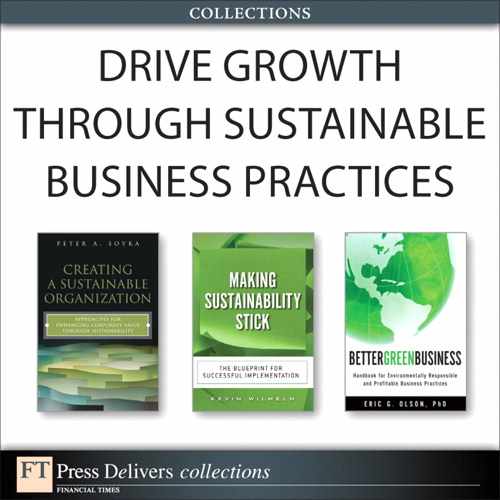Preface
In today’s information age, plenty of news reports and corporate pronouncements on environmental stewardship abound. But these show only a sample of the full breadth of activity underway. Business leaders and practitioners are exposed daily to a fray of news and magazine articles, television programming, “green” advertisements, organization announcements, and company press releases that describe plans, new products, and business benefits from initiatives that improve the environment.
Using this book, leaders and practitioners can begin to identify patterns in information. They can then learn what leading practices at other companies apply to their business, find areas where their enterprise should lead among its peers, and construct actionable plans to realize strategic objectives for environmental stewardship. You can appreciate that win-win-win scenarios still prevail in the green movement. For example, many businesses are benefiting from top-line revenue growth that has come from products, services, and business model innovations that are in line with environmental stewardship. Other businesses and consumers benefit from purchasing and using those products and services, from both increased efficiency and lower bottom-line costs. The global environment also benefits from lower greenhouse gas emissions and less resource consumption.
This book aims to give leaders and practitioners in any organization the practical insight necessary to help them move their enterprise toward a higher level of environmental stewardship, regardless of their current level of “green” maturity. It follows a holistic “strategy to implementation” approach, from strategy formulation to continuous improvement and beyond.
Chapter 1, “Driving Forces and Challenges That Organizations Face,” examines why environmental stewardship is important for any business to pursue, and why that importance will likely grow stronger in the future. Chapters 2, “Formulate Green Strategy to Complement Traditional Strategy,” and 3, “Green Strategy Supports Operational Improvements,” suggest a framework for approaching and formulating a green strategy, and illustrate the benefits many companies have realized in each strategic area. Chapter 4, “Make Green Strategy Actionable with a Proven Approach,” describes an approach for implementing a green strategy: developing a vision for the future, defining initiatives that fill gaps between the current state and the future vision, and constructing a roadmap for achieving the vision. The approach consistently maintains traceability throughout, from the investments made to fund specific initiatives, back to the driving strategic imperatives.
Chapters 5, “Transformation Methods and Green Sigma,” and 6, “Applying Green Sigma to Optimize Carbon Emissions,” introduce and explain business process transformation methodologies, with supporting technology and tools, that focus on increasing operational efficiency and reducing waste. IBM’s Green Sigma is one methodology described in detail.
The concepts in Chapters 7, “Instrumenting the Planet for an Intelligent, Sustainable World,” and 8, “Technology That Supports Instrumenting the Planet,” are forging new paths on the frontier of environmental stewardship; they play a central role in achieving the full business benefits that are possible from our increasingly intelligent planet. We cover the drivers and rationale for instrumenting the planet, describe applications for the associated solutions, and explain key elements of the underlying technology. Chapter 9, “Business Considerations for Technology Solutions,” describes the landscape of existing and developing technology solutions that apply to business operations and explains associated business considerations. Finally, Chapter 10, “Critical Trends Shaping the Future,” concludes with a discussion of long-term trends that will play a role in shaping the future of business management.
This book will be useful for readers who want to understand what is happening around the world, as related to green business and environmental stewardship, as well as those who want to learn how to take action to achieve tangible benefits. We discuss strategic insights for top-line revenue growth, bottom-line cost savings, and operational transformation, all of which executives will value. We also address how to make green strategy actionable, and describe transformation methodologies that managers and project leaders can use to improve their organizational competencies, processes, technologies, and operations. All practitioners, at every level of any organization, will gain insight into how different actions can fit into a broader framework of holistic, global change. Readers in any size enterprise or industry will also benefit from our discussion of frameworks for such things as green product categorization, solutions and technology for environmental stewardship, and ways to build strength and differentiation from the lifecycle chain outside the four walls of an organization.
In some cases, we quantify and explain detailed environmental benefits, and discuss numerous other examples at a higher level in the context of specific frameworks. The objective of this book is not to evaluate and analyze public policies and legislation that impact global warming, nor is it to explore the detailed science of global climate and associated weather change. Beyond the intellectual exercise of understanding the complexities of global environmental change and the sophisticated science behind that understanding, is the capacity for organizations of all kinds to connect the driving forces of environmental stewardship with actual initiatives that improve the environment, strengthen business performance, and lower risk. Businesses are already applying these principles to grow revenue, operate more efficiently, reduce costs, and improve environmental sustainability—all at the same time.
